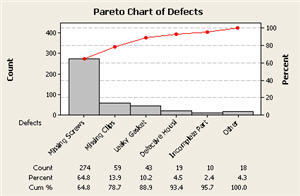
Step 4: Draw and label the left vertical axis. The resulting table is called the Pareto Table. Step 3: Determine the cumulative-percent of total.įor example, the cumulative-percent of total through the fifth contributor is the sum of the effects of the first five in rank ordering, divided by the grand total, and multiplied by 100. Step 2: Re-order the contributors from the largest to the smallest. To build the Pareto, they followed these steps: Step 1: Total the data on effect of each contributor, and sum these to determine the grand total. At the end of the week, the team collected the checksheets and tallied the results by specific cause. Customer service reps were asked to record the type of defects (or billing problems) for each customer call during a one-week study period. The following example will display the steps to construct a Pareto Diagram.Ī team wanted to reduce the number of billing problems.

If people do not believe the data, they will not support your team’s decision. Keep in mind that you are using Pareto analysis to support decision making.

Keep in mind that Pareto analysis is a comparison technique. Use the same measure for all contributors, and use the same assumptions and calculations throughout.Use facts, not opinions, as the basis for decision making.No matter how you develop the raw data for your Pareto analysis, to be successful, your data must: If, however, the data does not exist, your team should develop a means for gathering it. Sometimes, the data you need already exists in accounting systems, routine management reports, or the files of individuals in the organization. The list of contributors to the effect can come from a variety of sources: Group brainstorming sessions, cause-effect diagrams, process flow diagrams, or the data itself. It does not help to focus your team’s efforts if one of the “vital few” is titled “miscellaneous.” Otherwise, you may end up with “miscellaneous” or “unclassified” items. Make sure that you spend time identifying all of the potential contributors before you set out to gather the data. You cannot rank by different measures on the same Pareto table or diagram that would be “comparing apples to oranges.” Pareto analysis is a measured and ranked comparison. The measure (e.g., cost) must be the same for all contributors in the analysis. Typical measures include: Cost, time, number of errors or failures, percent of customers expressing an opinion, etc. The measure of quality can be anything that the team agrees will quantify the negative impact of the issue under consideration.

In this case, the data that is needed is any measure of quality, stratified by the various categories that contribute to the overall effect. Getting ReadyĪs with all the analytical tools, a good Pareto diagram starts with good data. With a calculator, graph paper, and a sharp pencil (or even better, a computer with spreadsheet and charting software), an improvement team can easily produce Pareto diagrams to help in decision making. Pareto diagrams are not hard to construct. Facilitation Skills for Project Leaders.Preparation for Certified Quality Engineers.Our excellence model is built on years of working with many companies with a whole range of challenges.


 0 kommentar(er)
0 kommentar(er)
